Dose response curve - Study guides, Class notes & Summaries
Looking for the best study guides, study notes and summaries about Dose response curve? On this page you'll find 1547 study documents about Dose response curve.
Page 4 out of 1.547 results
Sort by
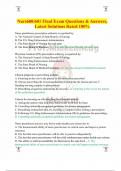
-
Nurs600/601 Final Exam Questions & Answers, Latest Solutions Rated 100%
- Exam (elaborations) • 35 pages • 2024
-
- $16.64
- + learn more
Nurs600/601 Final Exam Questions & Answers, Latest Solutions Rated 100%-Nurse practitioner prescriptive authority is regulated by: A. The National Council of State Boards of Nursing B. The U.S. Drug Enforcement Administration C. The State Board of Nursing for each state D. The State Board of Pharmacy - C. The State Board of Nursing for each state Physician Assistant (PA) prescriptive authority is regulated by: A. The National Council of State Boards of Nursing B. The U.S. Drug Enforceme...
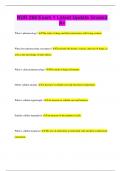
-
NUR 268 Exam 1 Latest Update Graded A+
- Exam (elaborations) • 38 pages • 2024
-
- $10.57
- + learn more
NUR 268 Exam 1 Latest Update Graded A+ What is pharmacology? The study of drugs and their interactions with living systems. What does pharmacology encompass? It includes the history, sources, and uses of drugs, as well as the knowledge of their effects. What is clinical pharmacology? The study of drugs in humans. Define cellular atrophy. A decrease in cellular size and functional components. What is cellular hypertrophy? An increase in cellular size and function. Explain ce...
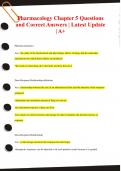
-
Pharmacology Chapter 5 Questions and Correct Answers | Latest Update | A+
- Exam (elaborations) • 19 pages • 2024
- Available in package deal
-
- $12.79
- + learn more
Pharmacodynamics Ans: the study of the biochemical and physiologic effects of drugs and the molecular mechanisms by which those effects are produced *the study of what drugs do to the body and how they do it Dose-Response Relationship definition Ans: relationship between the size of an administered dose and the intensity of the response produced -determines the minimum amount of drug we can use -the maximum response a drug can elicit -how much we need to increase the dosage in orde...

-
RADIATION PROTECTION (BIOLOGICAL ASPECTS OF RADIATION) ARRT EXAM QUESTIONS AND CORRECT DETAILED ANSWERS A+ GRADED
- Exam (elaborations) • 14 pages • 2024
- Available in package deal
-
- $14.49
- + learn more
The principal late effects of ionizing radiation on humans include tissue damage ic effects nant disease - ANS ic effects nant disease Late or long-term effects of radiation can occur in tissues as a result of chronic exposure or tissues that have survived a previous irradiation months or years earlier. These late effects, such as carcinogenesis and genetic effects, are "all-or-nothing" effects—either the organism develops cancer or it does not. Examples of late effects of ...
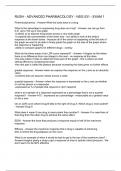
-
RUSH - ADVANCED PHARMACOLOGY - NSG 531 - EXAM 1
- Exam (elaborations) • 5 pages • 2024
-
- $10.99
- + learn more
Pharmicodynamics - Answer-What the body does to a drug What is the advantage to expressing drug dose as a log? - Answer--we can go from 0.01 ug to 100 ug in one graph -it allows us to express drug doses across a very wide range -it expands the concentration at the lower axis - our ability to look at the body's response at the lower doses - because all of the action is happening at the left side of the graph we want to be able to finely grade the graph on the side of the graph where the res...
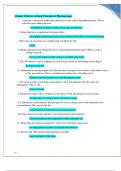
-
NR 565 Pharm midterm study guide questions with 100% correct answers updated 2024
- Exam (elaborations) • 23 pages • 2024
-
- $17.99
- + learn more
1. A patient’s nutritional intake and laboratory results reflect hypoalbuminemia. This is critical to prescribing because: Distribution of drugs to target tissue may be affected. 2. Drugs that have a significant first-pass effect: Are rapidly metabolized by the liver and may have little if any desired action 3.The route of excretion of a volatile drug will likely be the: Lungs 4. Medroxyprogesterone (Depo Provera) is prescribed intramuscularly (IM) to create a storage reservoir Increase ...
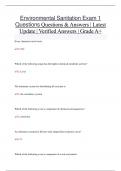
-
Environmental Sanitation Exam 1 Questions Questions & Answers | Latest Update | Verified Answers | Grade A+
- Exam (elaborations) • 14 pages • 2024
- Available in package deal
-
- $10.49
- + learn more
Every chemical can be toxic :: true Which of the following organ has the highest chemical metabolic activity? :: Liver The dominant system for distributing all toxicants is :: the circulatory system Which of the following is not a component of chemical carcinogenesis? :: remission An substance essential to life has what shaped dose-response curve? :: U Which of the following is not a component of a risk assessment. :: risk management Has endocrine disruption due to environmental chem...
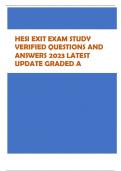
-
HESI EXIT EXAM STUDY VERIFIED QUESTIONS AND ANSWERS 2023 LATEST UPDATE GRADED A
- Exam (elaborations) • 49 pages • 2023
-
- $15.49
- 1x sold
- + learn more
HESI EXIT EXAM STUDY VERIFIED QUESTIONS AND ANSWERS 2023 LATEST UPDATE GRADED A A radiographer prepares to perform an AP projection of the distal femur on a patient with a suspected femoral fracture. Which represents the best approach for positioning both the patient and the x-ray tube? A. Rotate the leg 15 degrees medially; place the cathode end of the tube toward the foot. B. Rotate the leg 15 degrees medially; place the anode end of the tube toward the foot. C. Do not rotate the l...
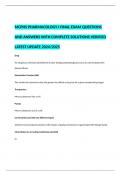
-
MCPHS PHARMACOLOGY I FINAL EXAM QUESTIONS AND ANSWERS WITH COMPLETE SOLUTIONS VERIFIED LATEST UPDATE 2024/2025
- Exam (elaborations) • 72 pages • 2024
-
Available in package deal
-
- $10.49
- + learn more
MCPHS PHARMACOLOGY I FINAL EXAM QUESTIONS AND ANSWERS WITH COMPLETE SOLUTIONS VERIFIED LATEST UPDATE 2024/2025 Drug An exogenous chemical administered to alter biological/physiological process to cure/treat/prevent disease/illness Dissociation Constant (Kd) The smaller the numerical value the greater the affinity a drug has for a given receptor/drug target Transporters Moves substances into a cell Pumps Moves substances out of a cell Ion-Channels (and the two different types) Selective...
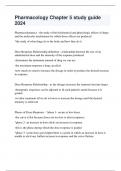
-
Pharmacology Chapter 5 study guide 2024
- Exam (elaborations) • 13 pages • 2024
-
- $14.49
- + learn more
Pharmacodynamics - the study of the biochemical and physiologic effects of drugs and the molecular mechanisms by which those effects are produced *the study of what drugs do to the body and how they do it Dose-Response Relationship definition - relationship between the size of an administered dose and the intensity of the response produced -determines the minimum amount of drug we can use -the maximum response a drug can elicit -how much we need to increase the dosage in order to produ...

How did he do that? By selling his study resources on Stuvia. Try it yourself! Discover all about earning on Stuvia


